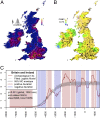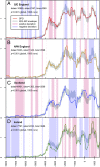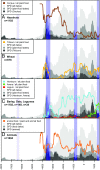Holocene fluctuations in human population demonstrate repeated links to food production and climate
- PMID: 29158411
- PMCID: PMC5724262
- DOI: 10.1073/pnas.1709190114
Holocene fluctuations in human population demonstrate repeated links to food production and climate
Erratum in
-
Correction for Bevan et al., Holocene fluctuations in human population demonstrate repeated links to food production and climate.Proc Natl Acad Sci U S A. 2018 Apr 10;115(15):E3597. doi: 10.1073/pnas.1804206115. Epub 2018 Apr 2. Proc Natl Acad Sci U S A. 2018. PMID: 29610300 Free PMC article. No abstract available.
Abstract
We consider the long-term relationship between human demography, food production, and Holocene climate via an archaeological radiocarbon date series of unprecedented sampling density and detail. There is striking consistency in the inferred human population dynamics across different regions of Britain and Ireland during the middle and later Holocene. Major cross-regional population downturns in population coincide with episodes of more abrupt change in North Atlantic climate and witness societal responses in food procurement as visible in directly dated plants and animals, often with moves toward hardier cereals, increased pastoralism, and/or gathered resources. For the Neolithic, this evidence questions existing models of wholly endogenous demographic boom-bust. For the wider Holocene, it demonstrates that climate-related disruptions have been quasi-periodic drivers of societal and subsistence change.
Keywords: Britain; Ireland; agriculture; archaeology; radiocarbon.
Copyright © 2017 the Author(s). Published by PNAS.
Conflict of interest statement
The authors declare no conflict of interest.
Figures




References
-
- Sheridan A. 2010. The neolithization of Britain and Ireland: The big picture. Landscapes in Transition, eds Finlayson B, Warren G (Oxbow Books, Oxford), pp 89–105.
-
- Parker Pearson M, et al. Beaker people in Britain: Migration, mobility and diet. Antiquity. 2016;90:620–637.
-
- Oloalde I, et al. 2017. The beaker phenomenon and the genomic transformation of northwest Europe. bioRxiv:10.1101/135962.
-
- Roberts BK, Wrathmell S. 2000. An Atlas of Rural Settlement in England, (2003 Corrected Reprint) (English Heritage, London)
Publication types
MeSH terms
LinkOut - more resources
Full Text Sources
Other Literature Sources

